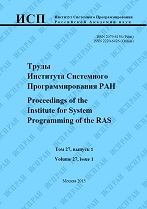|
This article is cited in 6 scientific papers (total in 6 papers)
Platform-independent and scalable tool for binary code clone detection
H. K. Aslanyan, S. F. Kurmangaleev, V. G. Vardanyan, M. S. Arutunian, S. S. Sargsyan
Institute for System Programming of the Russian Academy of Sciences
Abstract:
During the software development developers often copy and paste fragments of code to achieve the desired result. Copying of code can lead to variety of errors, as well as can increase the size of the source and binary code. The problem of finding semantically similar pieces of code (clones) in binary code becomes actual due to the unavailability of source code of many software programs. The first part of the article is dedicated to the analysis of the existing methods for finding code clone in binary code. In the second part we provide a newly developed tool for finding code clones in binary code. The work of the tool is divided into three main stages. The first stage is based on the Binnavi [1] framework, which is responsible for generation of program dependence graphs (PDG). Program dependence graphs are generated using REIL (Reverse Engineering Intermediate Language). The usage of REIL language allows to generate graphs for multiple architectures (x86, x86-64, ARM, MIPS, PPC), thus providing the independence of the tool from the target architecture. In the second step code clones are found based on previously created graphs. Maximum common subgraph is built for each pair of graphs and based on it, code clones are detected. In the third stage, the detected clones are visualized for convenient analysis of the results.
Keywords:
code clone, semantic analysis of binary code, REIL, program dependence graph.
Citation:
H. K. Aslanyan, S. F. Kurmangaleev, V. G. Vardanyan, M. S. Arutunian, S. S. Sargsyan, “Platform-independent and scalable tool for binary code clone detection”, Proceedings of ISP RAS, 28:5 (2016), 215–226
Linking options:
https://www.mathnet.ru/eng/tisp77 https://www.mathnet.ru/eng/tisp/v28/i5/p215
|

| Statistics & downloads: |
| Abstract page: | 241 | | Full-text PDF : | 138 | | References: | 41 |
|




 Contact us:
Contact us: Terms of Use
Terms of Use
 Registration to the website
Registration to the website Logotypes
Logotypes









 Citation in format
Citation in format 
